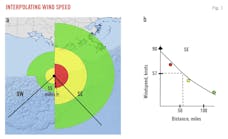USCG: Oil sheen in gulf matches deepwater Macondo spill
Story updated with BP statement, paragraphs 4-6
Samples collected from an oil sheen in the Gulf of Mexico matched samples of oil that originated from the deepwater Macondo well blowout and resulting spill in 2010 off Louisiana, the US Coast Guard confirmed. USCG has notified Macondo well operator BP PLC and drilling contractor Tranoscean Ltd.
Transocean owned the Deepwater Horizon semisubmersible, which sank after an explosion and fire associated with an Apr. 20, 2010, blowout. Eleven people aboard the semi were killed. The Deepwater Horizon drilled the Macondo well for BP and its partners.
“The sheen is not feasible to recover and does not pose a risk to the shoreline,” USGS said in an Oct. 9 Notice of Federal Interest issued to BP and Transocean. The exact source of the sheen is uncertain but could be residual oil from the Deepwater Horizon wreckage or debris left on the seabed, USCG said.
BP said monitoring efforts during the past few weeks continue to indicate the integrity of the Macondo well and its associated relief well.
"Like the Coast Guard, BP also has collected and analyzed sheen samples, which show a correlation with Macondo source oil but also indicate the presence of alpha-olefins, a compound found in the drilling mud but not in the source oil. This strongly suggests the oil is emanating from the debris from the Deepwater Horizon accident. The size of the sheen, its persistent point of origin, and other factors indicate the most likely source is the bent riser pipe that once connected the rig to the wellhead," BP said.
In September 2011, BP confirmed the integrity of the Macondo well with an remotely operated vehicle inspection that was conducted in the presence of a number of federal agencies.
The NOFI effectively informed BP and Transocean that USCG matched the sheen samples to the Macondo well or the drilling debris. Either or both companies might be held accountable for any cost associated with assessments or operations related to the sheen, USCG said.
BP reported the sheen to the National Response Center Sept. 16 based on satellite images from the Mississippi Canyon Block 252, which is 50 miles off Louisiana.
USCG, working with BP and National Oceanic and Atmospheric Administration officials, then assessed the sheen by aircraft and boat.
The observed sheen size has varied over time depending upon the conditions present. Samples of the sheen were taken by USCG Marine Safety Unit Morgan City Sept. 26 and sent to the USCG Marine Safety Lab in New London, Conn.
Separately, US Rep. Edward J. Markey (D-Mass.) on Oct. 11 called for a full undersea survey of the Macondo site to be posted live on the internet.
Hurricane Isaac uncovered limited amounts of residual oil associated with the Macondo spill, BP said in September, adding that the Macondo oil had been buried in isolated stretches of shoreline where BP had been cleaning before Isaac made landfall (OGJ Online, Sept. 11, 2012).
Government officials previously estimated nearly 5 million bbl of oil was spilled before the Macondo well was capped in July 2010 and permanently sealed with cement in September 2010. The well later was plugged and abandoned with the approval and oversight of the US Bureau of Ocean Energy Management, Regulation, and Enforcement.
The Deepwater Horizon Joint Investigation Team (JIT) released its final report on Sept. 14, 2011, saying the blowout stemmed from multiple causes and decisions involving BP and contractors Transocean and Halliburton Co.
Contact Paula Dittrick at [email protected].

Paula Dittrick | Senior Staff Writer
Paula Dittrick has covered oil and gas from Houston for more than 20 years. Starting in May 2007, she developed a health, safety, and environment beat for Oil & Gas Journal. Dittrick is familiar with the industry’s financial aspects. She also monitors issues associated with carbon sequestration and renewable energy.
Dittrick joined OGJ in February 2001. Previously, she worked for Dow Jones and United Press International. She began writing about oil and gas as UPI’s West Texas bureau chief during the 1980s. She earned a Bachelor’s of Science degree in journalism from the University of Nebraska in 1974.
